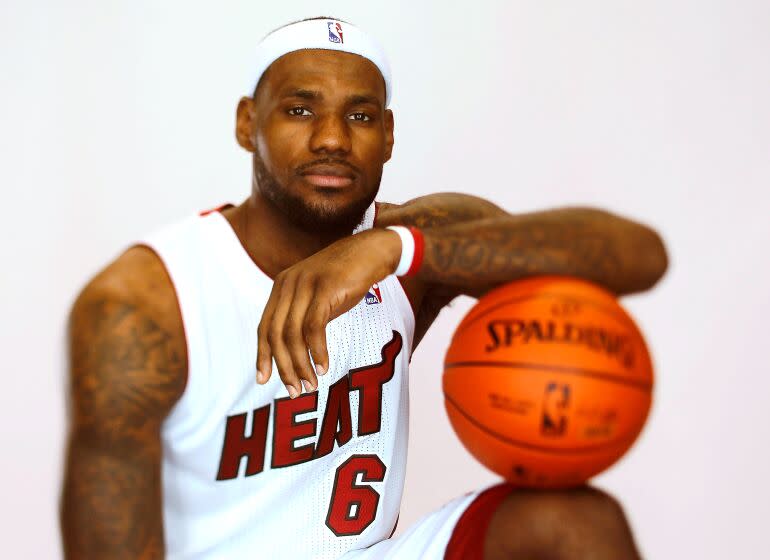Like its superstar subject, 'LeBron' biography doesn't miss a shot

- Oops!Something went wrong.Please try again later.
- Oops!Something went wrong.Please try again later.
LeBron James’ life and career make for a storyteller’s dream, a series of high-profile triumphs and setbacks, a hard upbringing that gave way to the upper echelons of sports, finance and celebrity.
Raised in Akron, Ohio, by a single mother with little money and plenty of demons, he emerged as the most dominant high school athlete in the country and a one-man industry in the making. Drafted by his hometown NBA team, the Cleveland Cavaliers, right out of high school, he broke the city’s heart when he left, then brought euphoria when he returned. Along the way he turned himself into a billion-dollar corporation with the help of an inner circle composed of three buddies he met as a teenager. He would eventually make friends with the likes of Barack Obama and Warren Buffett.
In short, there’s no shortage of material for a biographer to chronicle the current Los Angeles Laker, and Jeff Benedict’s comprehensive new “LeBron” does a masterful job of shaping that material into a cohesive and propulsive whole. This is a fast break of a book, slicing into the many mini-narratives that James has lived and artfully tying them together to create a portrait of a man who has, by his own design, remained an enigma except to those he decides to trust. Benedict has constructed a sort of sports opera fueled by the drama and emotion surrounding his subject, but never sensationalistic or unfair. Benedict clearly likes James, but he’s been around long enough — among the subjects of his 17 books are Tiger Woods and the New England Patriots — to steer far clear of hagiography.
Burned by many writers in his career, sometimes in stories shot through with casual, almost subconscious racism, James learned early to carefully curate his public life and image (which didn’t prevent him from committing perhaps the greatest public relations blunder in sports history). He did not talk to Benedict for “LeBron.” But the author’s reporting here is exhaustive; he interviewed almost 250 people for the book. The public record on James is voluminous, and Benedict used it extensively.
However, this is no clip job. Benedict writes scenes that make clear the extent of his primary reporting, putting the reader, to paraphrase a popular Broadway musical, in the room where it happens. You can practically see the goop in Miami Heat president Pat Riley’s hair as he seethes in resentment when James announces his departure from South Beach to return to Cleveland. “LeBron” isn’t just great sportswriting, it’s also vivid narrative journalism.
There have been other LeBron books, some written by the man himself (with collaboration from professional scribes). Indeed, writers walk on and off these pages like players in a layup line. Buzz Bissinger shows up to ghostwrite “LeBron’s Dream Team,” about James’ high school years; the Pulitzer winner found James’ unwillingness to open up (or promote the book) maddening. There’s Grant Wahl, who wrote the story that put James on the cover of Sports Illustrated while he was still in high school, a decision that caused much hand-wringing: What if they mess up this kid’s life? (Spoiler: They didn’t). James soon grew wary of sportswriters, most of them middle-aged white men turning his hardscrabble upbringing into a study in urban pathology.
There were exceptions, most notably Sports Illustrated’s Lee Jenkins, who gained James’ trust and penned the essay announcing James’ return to Cleveland. This was a public relations master stroke, an antidote of sorts to "The Decision," the ill-advised, nationally televised special in which James announced his decision to leave Cleveland for Miami. The spectacle, and its lack of humility, was a disaster, nearly causing riots back in Ohio and making James, for a time, the most hated person in sports.
But James is nothing if not resilient, and his instincts, on and off the court, tend to be uncanny. There’s an American dream quality to “LeBron,” the story of a kid who came from very little and gradually, meticulously built a hand-picked dream team of advisors and corporate partners that helped make him the most famous athlete in the world. His talent, of course, didn’t hurt; built like a particularly tall linebacker, he ran faster and jumped higher than any of his opponents. Benedict covers all of this thoroughly. But he also makes clear that James just thinks differently. He sees around corners, on and off the court. He didn’t just want to be a star, he wanted to transcend sports. As his friend Jay-Z put it in song, “I’m not a businessman, I’m a business, man.” The same could be said of James.
Eventually, James incorporated a social consciousness into his public persona. This process too included some stumbles. Early in his career, with the 2008 Summer Olympics approaching in Beijing, James’ Cavaliers teammate Ira Newble collected the team’s signatures to protest China’s complicity in the Darfur genocide. Everyone signed — except James. James is and was Nike’s biggest business investment, and Nike has big business in China. Still in his early 20s at the time, James didn’t want to rock the boat, and at that point in his career, he didn’t even really know how.
In other words, he is mortal, if exceptional. Benedict’s greatest feat here might be the way he cuts through both the public hysteria surrounding James and the superstar’s own protective field to paint a portrait of a man in full. Sports fans should eat “LeBron” up. But even casual observers will learn plenty about one of the most visible personalities of his generation.
This story originally appeared in Los Angeles Times.

